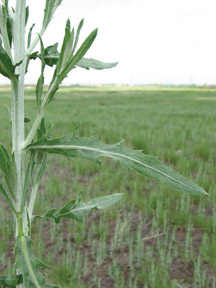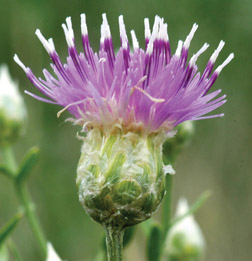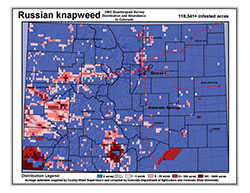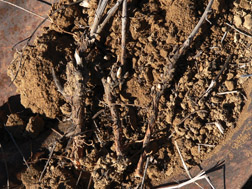by K.G. Beck * (11/13)
Quick Facts…
- Russian knapweed is a creeping perennial that reproduces from seed and vegetative root buds.
- Russian knapweed emerges in early spring, bolts in May to June, and flowers through the summer into fall.
- Russian knapweed is toxic to horses.
- The key to Russian knapweed control is to stress the weed and cause it to expend nutrient stores in its root system.
- The best management plan includes cultural controls combined with mechanical and/or chemical control techniques.

Figure 1. Russian knapweed rosette emergence in early spring. |

Figure 2: Russian knapweed shoot and leaves; note hairs and lobed leaves. |

Figure 3. Russian knapweed flower; note smooth papery bracts that lack any spines. |
Russian knapweed (Acroptilon repens) is a creeping, herbaceous perennial of foreign origin that reproduces from seed and vegetative root buds. Shoots, or stems, are erect, 18 to 36 inches tall, with many branches. Lower leaves are 2 to 4 inches long and deeply lobed (Figure 1). Upper leaves are smaller, generally with smooth margins, but can be slightly lobed (Figure 2). Shoots and leaves are covered with dense gray hairs. The solitary, urn-shaped flower heads occur on shoot tips and generally are 1/4 to 1/2 inch in diameter with smooth papery bracts. Flowers can be pink, lavender or white (Figure 3). Russian knapweed has vertical and horizontal roots that have a brown to black, scaly appearance, especially apparent near the crown.
The weed forms dense, single species stands over time due to competition and allelopathy (biochemicals it produces that inhibit the growth of other plants). A 2008 survey conducted by the Colorado Department of Agriculture showed Colorado with more than 132,400 acres infested with Russian knapweed (Figure 4). Russian knapweed is toxic to horses.
Phenology, Biology and Occurrence
Russian knapweed emerges in early spring, bolts in May to June (elevation dependent) and flowers through the summer into fall. It produces seeds sparingly, approximately 50 to 500 per shoot. Seeds are viable for two to three years in soil. Its primary method of reproduction is from vegetative propagation, with seed of secondary importance. Roots from a recently established plant expand rapidly and may cover up to 12 square yards in two growing seasons.
Russian knapweed is native to southern Ukraine, southeast Russia, Iran, Kazakhstan and Mongolia. It grows on clay, sandy or rocky prairies and sunny meadows; on saline soils; or clay, rocky or sandy shores of lakes and rivers; and on rocky and clay slopes of hills and bottomlands. It is a weed of cultivated land, dry pastures and degraded noncropland (waste places) in its native land. Russian knapweed grows in most western states. In Washington, it is common on heavier, often saline soils of bottomlands and grows in pastures, hayfields, grainfields and irrigation ditches. In Colorado, Russian knapweed is not restricted to certain soils and occurs in pastures, agronomic crops, roadsides, waste places and rangeland. Stands may survive 75 years or longer.
Management
Like other creeping perennials, the key to Russian knapweed control is to stress the weed and cause it to expend nutrient stores in its root system. An integrated management plan should be developed that places continual stress on the weed. Currently, the best management plan includes cultural control combined with mechanical and/or chemical control techniques. A single control strategy, such as mowing or a herbicide, usually is not sufficient.
Russian knapweed typically invades degraded areas, dominating the plant community and desirable plants (e.g. perennial grasses). Seeding competitive, perennial grass species (cultural control) after Russian knapweed has been stressed by other control measures (set-up treatments) is essential. Set-up treatments may include chemical or mechanical methods.

Figure 4. 2008 distribution of Russian knapweed in Colorado. |
Cooperative research between Colorado State University and the University of Wyoming showed that chemical set-up treatments were superior to mowing. Curtail (clopyralid + 2,4-D), Escort (metsulfuron), and Roundup (glyphosate) were used to suppress Russian knapweed. Then perennial grasses were sown in late fall as a dormant seeding. Curtail (3 quarts per acre) (A) or Escort (1 ounce/A) were applied at the bud-growth stage. Roundup was applied twice at 1 quart/A, first at the bud-growth stage and again about 8 weeks later. Curtail controlled Russian knapweed best and Roundup failed to control it. None of the herbicides injured seeded grasses. Grasses established similarly among herbicide suppression treatments, even though Russian knapweed control varied. However, where Escort or Roundup was used to suppress Russian knapweed, additional herbicide treatments would be necessary to achieve acceptable control.

Figure 5. Russian knapweed root buds on crowns in fall; note black/brown scaly appearance to root crowns—a key identifying characteristic. |

Figure 6. Russian knapweed emerged rosettes in fall. |
While two mowings eight weeks apart (first at bud growth stage), suppressed Russian knapweed during that year, the weed recovered vigorously the subsequent growing season. Perennial grasses established in the mowing treatments but much less than in herbicide treatments. Seeding desirable forbs and shrubs also may be effective to prevent Russian knapweed reinvasion, but research is necessary to test this hypothesis.. Two mowings per year for several years may control Russian knapweed better than in our experiments, but further research also is needed to test this hypothesis. Currently no biological control is available for this weed. Tillage often is necessary to overcome the residual allelopathic effects of Russian knapweed, but more recent research shows that an effective herbicide treatment that kills much of the root system also appears to ameliorate allelopathy.
Chemical control. In most circumstances, an herbicide alone will not effectively manage Russian knapweed. However, there may be situations where desirable plants within a Russian knapweed infestation may compete effectively with the weed if it is stressed with a single weed management technique.
Russian knapweed is controlled by Tordon 22K (picloram), Milestone (aminopyralid), Transline (clopyralid), Curtail, (clopyralid + 2,4-D), Perspective (aminocyclopyrachlor + chlorsulfuron), and Telar (chlorsulfuron). Refer to Table 1 for rates and timing recommendations and always read the herbicide label before using the product. Russian knapweed is very susceptible to fall-applied herbicides. It displays a distinct cycle of root bud development. In late summer (August into early September) Russian knapweed begins to develop buds on its roots that will emerge to form rosettes that fall or the following spring (Figures 5 and 6). Root buds continue to grow throughout the winter but once rosettes emerge in spring, remaining root buds slough off and no buds occur on roots until this cycle begins again in late summer. This active root bud growth and development in fall through winter may be the reason that Russian knapweed is susceptible to herbicides applied in fall and winter.
| When integrating chemical and cultural control, avoid using herbicide rates that injure grasses because effective competition will be reduced. |
Cultural control. Russian knapweed tends to form monocultures and usually eliminates other plants. Therefore, sowing desirable plant species is necessary after the weed is controlled. Smooth brome will compete with Russian knapweed. Research shows that streambank wheatgrass, thickspike wheatgrass, crested wheatgrass and Russian wildrye established after Russian knapweed was suppressed with herbicides. Sod-forming perennial grasses, like streambank or thickspike wheatgrasses, help prevent reinvasion better than bunch grasses like crested wheatgrass. More recent CSU research also shows that slender wheatgrass and western wheatgrass also compete effectively with Russian knapweed after it is suppressed.
If the Russian knapweed stand is not too old and grasses are still present, stimulating grass growth by irrigation (where possible) should increase grass competition with knapweed and keep the weed under continual stress.
| Table 1. Herbicide used to control Russian knapweed. | |||
| Herbicide | Rate (Product/A) | Application timing |
Comments |
| Tordon | 2 to 4 pints | Spring at bud to mid-flowering growth stages; or late in fall | Use higher rates for older or dense stands; late treatments in fall to dormat plants very effective |
| Milestone | 5 to 7 fl oz | Spring and summer at bud to flowering growth stages; or late in fall | Use higher rate for older stands; late treatments in fall to dormant plants very effective; Milestone may be used to edge of ponds or streams |
| Transline | 1 to 1.33 pints | Spring after all shoot have emerged, bud to mid-flower growth stages; late in or fall | Use higher rate for older or dense; late treatments in fall to dormant plants very effective |
| Curtail | 3 to 4 quarts | Spring after all shoots have emerged, bud to mid-flower growth stages; late in or fall | Use higher rate for older or dense; late treatments in fall to dormant plants very effective |
| Perspective | 5.5 oz | Spring after shoots have emerged through the fall | Late fall treatments into winter when conditions are suitable for spraying is very effective |
| Telar | 1 oz | Spring bud to flowering growth state; or late in fall | Late treatments in fall to dormant plants are very effective; temporary injury to cool season grasses may occur from fall treatments |
* Colorado State University Extension weed specialist and professor, bioagricultural sciences and pest management. 9/98. Revised 11/13.
Colorado State University, U.S. Department of Agriculture, and Colorado counties cooperating. CSU Extension programs are available to all without discrimination. No endorsement of products mentioned is intended nor is criticism implied of products not mentioned.
Go to top of this page.





